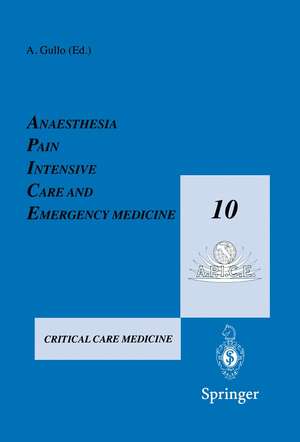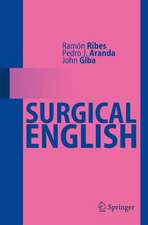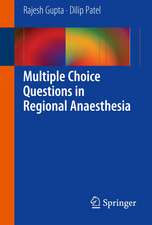Anaesthesia, Pain, Intensive Care and Emergency Medicine — A.P.I.C.E.: Proceedings of the 10th Postgraduate Course in Critical Care Medicine Trieste, Italy — November 13–19, 1995
Autor Antonio Gulloen Limba Engleză Paperback – 31 oct 1995
| Toate formatele și edițiile | Preț | Express |
|---|---|---|
| Paperback (2) | 413.90 lei 6-8 săpt. | |
| Springer – 31 oct 1996 | 413.90 lei 6-8 săpt. | |
| Springer – 31 oct 1995 | 418.09 lei 6-8 săpt. |
Preț: 418.09 lei
Preț vechi: 440.10 lei
-5% Nou
Puncte Express: 627
Preț estimativ în valută:
80.03€ • 86.96$ • 67.27£
80.03€ • 86.96$ • 67.27£
Carte tipărită la comandă
Livrare economică 21 aprilie-05 mai
Preluare comenzi: 021 569.72.76
Specificații
ISBN-13: 9783540750147
ISBN-10: 3540750142
Pagini: 1052
Ilustrații: XXVIII, 1022 p.
Dimensiuni: 170 x 244 x 55 mm
Greutate: 1.64 kg
Ediția:Softcover reprint of the original 1st ed. 1996
Editura: Springer
Colecția Springer
Locul publicării:Milano, Italy
ISBN-10: 3540750142
Pagini: 1052
Ilustrații: XXVIII, 1022 p.
Dimensiuni: 170 x 244 x 55 mm
Greutate: 1.64 kg
Ediția:Softcover reprint of the original 1st ed. 1996
Editura: Springer
Colecția Springer
Locul publicării:Milano, Italy
Public țintă
ResearchCuprins
Basics of Critical Care Medicine.- Anaesthesia.- Why Are Hypertensive Patients at Risk in the Perioperative Period?.- Pain.- Acute Pain Modulation in the Central Nervous System: A Chronological Review.- Homeostasis.- Lactic Acidosis: Diagnosis and Treatment.- Metabolism.- Immunonutrition — A New Aspect in the Treatment of Critically Ill Patients.- Pharmacology.- Pharmacological Interactions in the Perioperative Period.- Injury and Tissue Damage.- Cellular and Humoral Markers of Tissue Damage.- Role of Free Radicals in Critical Illness.- Pathophysiology and Therapy of End-Organ Failure in Critical Illness.- Organ Perfusion.- Research Studies on Organ Perfusion: From the Lab to the Clinic.- Ischemic Microvascular Failure in Severe Head Injury.- Intestinal Microvascular Injury.- Vasoactive Drugs and Splanchnic Perfusion.- Perfusion in Renal Dysfunction.- Oxygen Supply Dependency — Fact or Artifact?.- Debate on DO2/VO2 Dependency During Inotropic Treatment.- Cellular and Humoral Activity in Trauma and Sepsis.- The Endothelium: A New Secretory Organ Target or Promoter of Pathophysiological Derangements in ICU Patients.- Antioxidant Activity in the Therapy of Sepsis: From Experimental Data to Clinical Practice.- Posttrauma Oxygen Debt and Its Metabolic Consequences.- Chest Imaging in the ICU.- Lung Disease in the ICU: A DifGcult Diagnostic Challenge.- Pulmonary Oedema.- A Window with a View of the Water.- Radiological Monitoring of Pulmonary Edema.- Pulmonary Embolism.- MR Imaging in Venous Thromboembolism.- Pulmonary Embolism: Role of Spiral CT.- Vascular Techniques in Pulmonary Embolism.- New Modes of Artificial Ventilation.- Proportional Assist Ventilation (PAV): Physiologic Rationale and Clinical Advantages.- Airway Pressure Release Ventilation.- High Frequency Positive Pressure Ventilation.- High Frequency Oscillation.- Insufflation of Air / Oxygen into the Trachea: An Old Principle with New Perspectives.- Concept: Open Up the Lung and Keep the Lung Open.- Computer Supported Ventilation.- Artificial Ventilation at the Bedside.- The Problem of Weaning in COPD Patients.- Respiratory Support Strategies in AIDS.- Advances in Respiratory Mechanics.- Mathematical Models in Respiratory Mechanics.- Evolution of Theories and Interpretation of Respiratory Mechanics Data.- Assessment of the Viscoelastic Constants Using the Rapid Airway Occlusion Technique.- Invasive and Noninvasive Haemodynamic Monitoring.- Technical Aspects of Haemodynamic Monitoringm.- Pressure Wave Modifications in Different Cardiac and Respiratory Events.- Noninvasive Pressure Measurements.- Noninvasive Cardiac Output Measurements.- Haemodynamic Profile and PetCO2 Monitoring in Patients at Risk.- Trauma Operative Procedures (T.O.P.).- The Development of the Trauma System: Epidemiological Data.- Evaluation and Triage. Current Use and Utility of the Trauma Scoring Systems.- What Can We Do During the “Golden Hour” ?.- Care of Trauma Patients: In-hospital Phase.- Prehospital Care for Severe Trauma Patients: What Do We Mean by ALS?.- Multivariable Physiologic Monitoring as a Guide to the Severity and Appropriate Therapy of Posttrauma ICU Patients.- Optimisation of Oxygen Transport in Polytraumatised Patients.- The Role of the Anesthesiologist During Nonconventional War.- Cerebral and Spinal Dysfunction.- Coma, Persistent Vegetative State, and Death.- Pathophysiology and Monitoring of Cerebral Edema.- Monitoring of Cerebral Dysfunction: Treatment of Post-traumatic Cerebral Injury.- The Glasgow Coma Scale After 20 Years.- Clinical Trials in Acute CNS Injuries.- Biochemical Mechanisms of Neuronal Degeneration and Plasticity.- Oxidative Stress in the Early Phase of Traumatic Central Nervous System Injury: Clinical Data.- Monitoring and Management of Patients with Cerebral and Spinal Dysfunction in Postintensive Care.- CSF Filtration: Scientific and Clinical Update.- Scoring Systems ’95.- Acubase: Fundamentals and Perspectives.- Perioperative Problems in Obese Patients.- Obesity and Coexisting Diseases: Anesthesiological Point of View.- Intubation by Fibroscopy in Morbidly Obese Patients.- Total Respiratory System, Lung and Chest Wall Mechanics, Lung Volumes and Gas-Exchange in Morbidly Obese Patients During General Anesthesia.- Bariatric Surgery: Indications and Comphcations.- Anaesthesiological and Surgical Problems in Lung Transplantation.- Lung Transplantation: Aspects of Anaesthetic and Early Postoperative Management.- Progress in Lung Transplantation.- Nitric Oxide in Pulmonary Hypertension.- Technological and Clinical Advances.- Difficult Tracheal Intubation and Airway Management.- Airway Management.- Electrolyte Emergencies (Mg,K).- Patient Controlled Analgesia (PCA): Clinical Experience.- Management of Acute Myocardial Infarction.- Anaesthesia for Abdominal Vascular Surgery.- Ischemia-Reperfusion in Vascular Surgery.- Acidosis in the Critically Ill: Interpretation and Significance.- Use of the Gaps in the Critically Ill.- Continuous Noninvasive Aortic Blood Flow Monitoring.- How to Manage Critically Ill Patients After Cardiac Surgery.- Transfusion and Thromboembolic Prophylaxis.- Management of Common Poisoning in the ICU.- Laryngeal Mask in Clinical Anaesthesia.- The Role of the Laryngeal Mask in Clinical Practice.- Controversies in the Management of Critically Ill Patients.- Pancreas Dysfunction and Related Problems.- Updating Computer Usage in the ICU.- Flow of Information in the ICU — An Overview.- From Human Action to Data: Man-Machine Interface in Manual Data Entries.- From Trends to Multi-Information-Screens in Computing in the ICU.- Artificial Intelligence for Decision Support: Needs, Possibilities, and Limitations in ICU.- Beyond Trends: Graphics for Decision Support.- ICU and the Outside World: Multimedia and Networking in the ICU Environment.- Interactive Multimedial Teaching.- Advances in Inhalatory Anaesthesia.- How to Detect Cardiovascular Dysfunction in the Perioperative Period.- Cardiovascular and Neuroendocrine Reaction During Inhalation Anaesthesia.- Common Use and Monitoring of Cardiovasoactive Drugs in General Anesthesia Using Halogenated Agents.- Circulatory Effects of Desflurane.- Desflurane: How Does It Work?.- Total Intravenous Anaesthesia.- Principles and Technique of I.V. Anesthesia.- Management in Anaesthesia.- Anesthesiologist as Manager in the U.S.A.: The Ambulatory Surgery Experience.- Day Surgery Experience in the United Kingdom.- Sanitary Organization and Safety.- Recommendations for Anesthesia in Day Hospital.- Pharmacoeconomics in Anaesthesia.
Descriere
Descriere de la o altă ediție sau format:
At the APICE '96 research scientists and clinicians were provided with updated guidelines for the treatment of patients with acute and chronic critical conditions. This volume contains 100 chapters,in which the main pathophysiological concepts were reviewed, with special emphasis on the cardiovascular, respiratory, metabolic, and neurologic systems. Special reference is made to the pharmacologic and biotechnologic strategies currently being used to support those vital functions that are affected by severe and sometimes devastating diseases. The topics of infection, sepsis,and SIRS have been reviewed and updated in keeping with the most recent information available, and particular focus has been directed to ethics.
At the APICE '96 research scientists and clinicians were provided with updated guidelines for the treatment of patients with acute and chronic critical conditions. This volume contains 100 chapters,in which the main pathophysiological concepts were reviewed, with special emphasis on the cardiovascular, respiratory, metabolic, and neurologic systems. Special reference is made to the pharmacologic and biotechnologic strategies currently being used to support those vital functions that are affected by severe and sometimes devastating diseases. The topics of infection, sepsis,and SIRS have been reviewed and updated in keeping with the most recent information available, and particular focus has been directed to ethics.

















